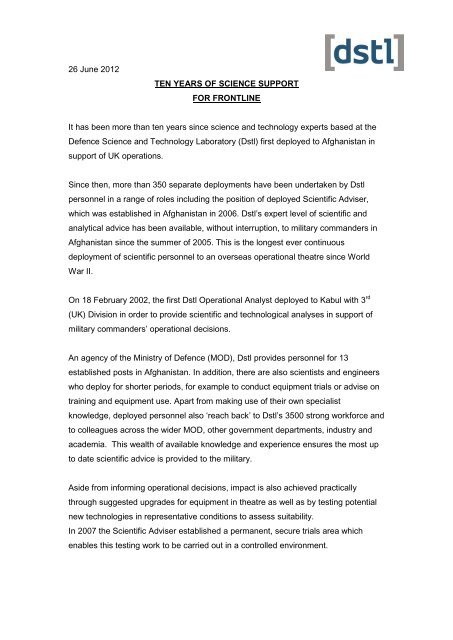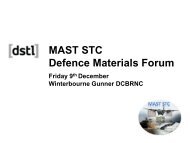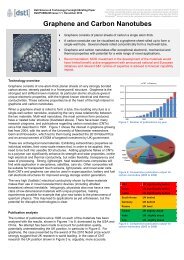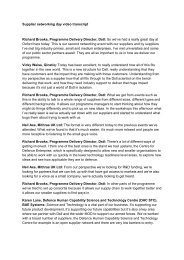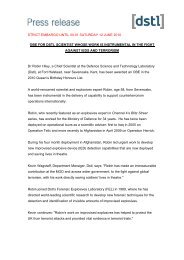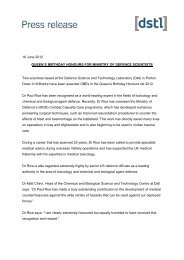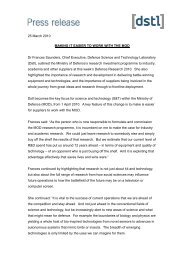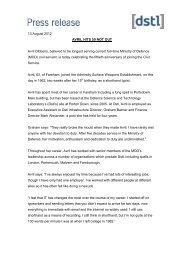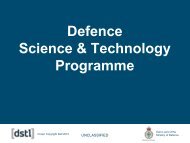Ten years of science support for frontline - Dstl
Ten years of science support for frontline - Dstl
Ten years of science support for frontline - Dstl
You also want an ePaper? Increase the reach of your titles
YUMPU automatically turns print PDFs into web optimized ePapers that Google loves.
26 June 2012<br />
TEN YEARS OF SCIENCE SUPPORT<br />
FOR FRONTLINE<br />
It has been more than ten <strong>years</strong> since <strong>science</strong> and technology experts based at the<br />
Defence Science and Technology Laboratory (<strong>Dstl</strong>) first deployed to Afghanistan in<br />
<strong>support</strong> <strong>of</strong> UK operations.<br />
Since then, more than 350 separate deployments have been undertaken by <strong>Dstl</strong><br />
personnel in a range <strong>of</strong> roles including the position <strong>of</strong> deployed Scientific Adviser,<br />
which was established in Afghanistan in 2006. <strong>Dstl</strong>’s expert level <strong>of</strong> scientific and<br />
analytical advice has been available, without interruption, to military commanders in<br />
Afghanistan since the summer <strong>of</strong> 2005. This is the longest ever continuous<br />
deployment <strong>of</strong> scientific personnel to an overseas operational theatre since World<br />
War II.<br />
On 18 February 2002, the first <strong>Dstl</strong> Operational Analyst deployed to Kabul with 3 rd<br />
(UK) Division in order to provide scientific and technological analyses in <strong>support</strong> <strong>of</strong><br />
military commanders’ operational decisions.<br />
An agency <strong>of</strong> the Ministry <strong>of</strong> Defence (MOD), <strong>Dstl</strong> provides personnel <strong>for</strong> 13<br />
established posts in Afghanistan. In addition, there are also scientists and engineers<br />
who deploy <strong>for</strong> shorter periods, <strong>for</strong> example to conduct equipment trials or advise on<br />
training and equipment use. Apart from making use <strong>of</strong> their own specialist<br />
knowledge, deployed personnel also ‘reach back’ to <strong>Dstl</strong>’s 3500 strong work<strong>for</strong>ce and<br />
to colleagues across the wider MOD, other government departments, industry and<br />
academia. This wealth <strong>of</strong> available knowledge and experience ensures the most up<br />
to date scientific advice is provided to the military.<br />
Aside from in<strong>for</strong>ming operational decisions, impact is also achieved practically<br />
through suggested upgrades <strong>for</strong> equipment in theatre as well as by testing potential<br />
new technologies in representative conditions to assess suitability.<br />
In 2007 the Scientific Adviser established a permanent, secure trials area which<br />
enables this testing work to be carried out in a controlled environment.
In 2008, the Scientific Adviser developed an in-theatre solution to improve a<br />
particular vehicle’s level <strong>of</strong> protection against Improvised Explosive Devices (IEDs)<br />
by designing, testing and bolting on additional armour protection. Subsequently, one<br />
<strong>of</strong> these vehicles struck an IED and <strong>for</strong>tunately all <strong>of</strong> the vehicle occupants walked<br />
away from the incident. It was considered that had the temporary armour not been<br />
present, casualties would likely have been sustained. The additional protection was<br />
fielded on all vehicles in that fleet thus providing further improvement to the<br />
protection <strong>of</strong> the soldiers.<br />
More recently, a team <strong>of</strong> deployed <strong>Dstl</strong> staff, including the Scientific Adviser and<br />
Operational Analysts, worked together to test an Operational Concept Demonstrator<br />
(OCD) <strong>for</strong> a shot detection system to locate sharpshooters. The Operational Analysts<br />
used historic records <strong>of</strong> small arms fire to identify suitable areas and patrols where<br />
the system would have most utility. This would enable the Scientific Adviser and trials<br />
team to thoroughly test the OCD and evaluate its capabilities. The shot detection<br />
system is now used in Afghanistan and has been successfully identifying insurgent<br />
firing positions since it was delivered in 2011 by the MOD procurement organisation<br />
Defence Equipment and Support (DE&S), thus improving the protection <strong>of</strong><br />
dismounted soldiers.<br />
Rene Nevola, who has deployed in both the Scientific Adviser and more recently in<br />
the Operational Analyst role has just returned from Afghanistan (his fourth<br />
operational tour) and said: “We’re relatively few, in terms <strong>of</strong> numbers <strong>of</strong> deployed<br />
staff, but we can really get to grips with the issues by working alongside the military<br />
every, single day. We work long hours and are under pressure a lot <strong>of</strong> the time but<br />
from when we’re asked by Commanders ‘what have you done <strong>for</strong> a soldier today’<br />
it’s clear that our input is valued and important. It feels good to use the skills and<br />
experience that I have to directly benefit front line troops and to see that effect each<br />
day.”<br />
Colonel Colin McClean, Equipment Capability Commander, directly <strong>support</strong>ed by<br />
Rene in Joint Force Support says: “It would be inconceivable, were we to deploy on<br />
operations in the future, that we would not have [<strong>Dstl</strong>’s] capability available to the<br />
Military. Our soldiers would not be as well served if it were not <strong>for</strong> the excellent<br />
relationship we’ve got, the subject matter expertise <strong>Dstl</strong> provides and their<br />
commitment to the fight.”
<strong>Dstl</strong> Programme Leader <strong>of</strong> Support to Operations, Nick Barrett, who has deployed<br />
twice said: “The impact <strong>of</strong> <strong>Dstl</strong> deployed scientists to operations in Afghanistan has<br />
been displayed by improving equipment and in<strong>for</strong>ming operational battle-winning<br />
decisions with scientific grounding.”<br />
ENDS<br />
Notes to editors:<br />
There is video footage, including a package on Rene Nevola and colleagues in<br />
theatre available on www.dni.mod.uk. Login: User name – GuestUser; Password –<br />
WhiteBoard.<br />
Other examples <strong>of</strong> work carried out by <strong>Dstl</strong> staff in these deployed roles include:<br />
• The development and implementation <strong>of</strong> a new three-tiered pelvic protection<br />
system to reduce the volume and severity <strong>of</strong> injuries suffered by soldiers in<br />
IED strikes. Tier 1 undershorts are now standard issue and the garments<br />
have been praised by the surgeons in theatre <strong>for</strong> “significantly reducing the<br />
severity <strong>of</strong> trauma seen.” On return to the UK, the Scientific Adviser involved<br />
in the Pelvic Protection campaign was given a message <strong>of</strong> personal thanks<br />
from the girlfriend <strong>of</strong> a seriously injured soldier who can still have children<br />
because he was wearing the protection system.<br />
• Analysis <strong>of</strong> the security processes and ‘bottlenecks’ when vehicles are<br />
cleared by security staff on arrival at Camp Bastion led to increased efficiency<br />
and decreased delays without the extra provision <strong>of</strong> manpower or real estate.<br />
This analysis drew on the Operational Analyst’s expertise <strong>of</strong> flows in security<br />
systems and ensuring that each <strong>of</strong> the processes occurred in the correct<br />
order to be most efficient.<br />
• In 2010, <strong>Dstl</strong> operational analysis assistance was provided to the planners <strong>of</strong><br />
Operation MOSHTARAK, which was at that point the largest tactical UK<br />
operation. Commanders were provided with casualty estimates and hospital<br />
planning analyses to assess the viability <strong>of</strong> existing infrastructure to <strong>support</strong><br />
the operation. Mitigation strategies were considered as a result <strong>of</strong> the<br />
analyses and led to additional medical equipment and staff being deployed <strong>for</strong><br />
the high-tempo period <strong>of</strong> the operation.
• Over the decade <strong>Dstl</strong> has assisted in providing equipment upgrades on bomb<br />
disposal equipment. This has helped the armed <strong>for</strong>ces to undertake this<br />
difficult and dangerous job, whilst minimising the risk to the bomb disposal<br />
operative. These upgrades, <strong>of</strong>ten rapid solutions developed in theatre, have<br />
to be agile in order to defeat emerging threats. The knowledge gained from<br />
these developments may then feed back into the long term research<br />
programme.<br />
• Theatre trials <strong>of</strong> camouflage patterns has led to the first change in standard<br />
issue UK camouflage in 40 <strong>years</strong>. The Multi-Terrain Pattern (MTP)<br />
camouflage was tested extensively in theatre to ensure per<strong>for</strong>mance was <strong>of</strong> a<br />
high standard across the varied terrains encountered on operations.


